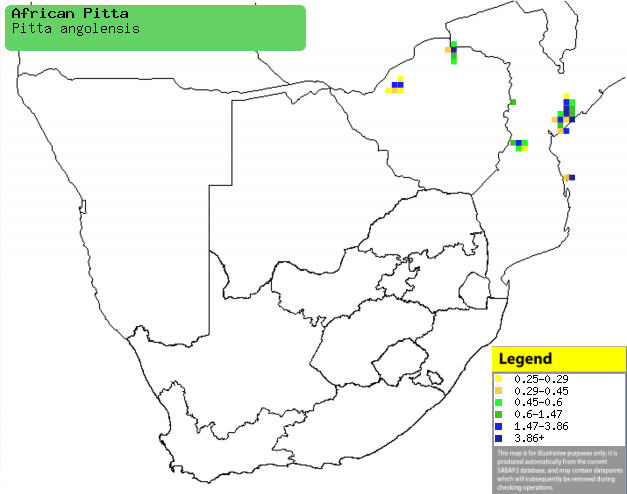|
Pitta angolensis (African pitta, Angola pitta)
Angolapitta [Afrikaans]; Angola-pitta [Dutch];
Brève de l'Angola [French]; Angolapitta [German]; Pita de Angola
[Portuguese]
Life
> Eukaryotes
>
Opisthokonta
> Metazoa
(animals) > Bilateria > Deuterostomia >
Chordata > Craniata > Vertebrata (vertebrates) > Gnathostomata (jawed
vertebrates) > Teleostomi (teleost fish) > Osteichthyes (bony fish) > Class:
Sarcopterygii (lobe-finned fish) > Stegocephalia (terrestrial vertebrates) >
Tetrapoda (four-legged vertebrates) > Reptiliomorpha > Amniota >
Reptilia
(reptiles) > Romeriida > Diapsida > Archosauromorpha > Archosauria >
Dinosauria (dinosaurs) > Saurischia > Theropoda (bipedal predatory
dinosaurs) > Coelurosauria > Maniraptora > Aves (birds) >
Order: Passeriformes > Family: Pittidae
The African pitta is an intra-African breeding migrant,
arriving in southern and south-central Africa to breed around November-December,
then departing around March-April for its non-breeding grounds in equatorial
Africa. In southern Africa it is scarce and localized, mainly occupying
evergreen forest or dense thickets, often on the banks of rivers or streams,
foraging for invertebrates in the leaf litter. Its nest is a dome-shaped
structure made of twigs, leaves and plant debris, usually placed in the
uppermost branches of a tree sapling. It lays 2-4 eggs, which hatch into chicks
with black skin and orange bills. Strangely enough, the chicks do not beg for
food, they just patiently wait with their mouths open until they are given
something.
Distribution and habitat
It has two major migrating populations: one in coastal West
Africa and the other in the area from the DRC to Mozambique, extending
marginally into southern Africa. Here it is scarce and localized, with scattered
populations in northern Mozambique and parts of Zimbabwe, with a few of vagrants
recorded in Limpopo Province, KwaZulu-Natal and even the Eastern Cape. It
usually occupies evergreen forest or dense thickets, often on the banks of
rivers or streams.
|
 |
|
Distribution of African pitta in southern Africa,
based on statistical smoothing of the records from first SA Bird Atlas
Project (©
Animal Demography unit, University of
Cape Town; smoothing by Birgit Erni and Francesca Little). Colours range
from dark blue (most common) through to yellow (least common). |
Movements and migrations
It is an intra-African breeding migrant, arriving in
southern and south-central Africa to breed around November-December, then
departing around March-April for its non-breeding grounds in the DRC, Uganda and
Kenya.
Food
It African pitta exclusively eats invertebrates, usually
foraging in leaf litter, searching for prey. Once it spots a prey item it stabs
it with its bill, killing it instantly. Its diet has not been studied very well,
however it is thought to eat the following prey items:
Breeding
- It builds its own nest, which is a dome-shaped structure made of sticks,
leaves and plant detritus, about 25-35 cm wide and 18-20 cm high, with a
small entrance hole on the side. It is normally placed in the upper branches
of a tree sapling, which in Zimbabwe is often a thorny species, such as
Ziziphus mucronata (Buffalo-thorn), Ximenia (sourplum) or
Acacia ataxacantha (Flame thorn).
- Egg-laying season is from November-January.
- It lays 2-4 eggs, which hatch into chicks with black skin and orange
bills. Strangely enough, the chicks do not beg for food, they just patiently
wait with their mouths open until they are given something.
Threats
Not threatened.
References
-
Hockey PAR, Dean WRJ and Ryan PG 2005. Roberts - Birds of
southern Africa, VIIth ed. The Trustees of the John Voelcker Bird Book
Fund, Cape Town.
|
